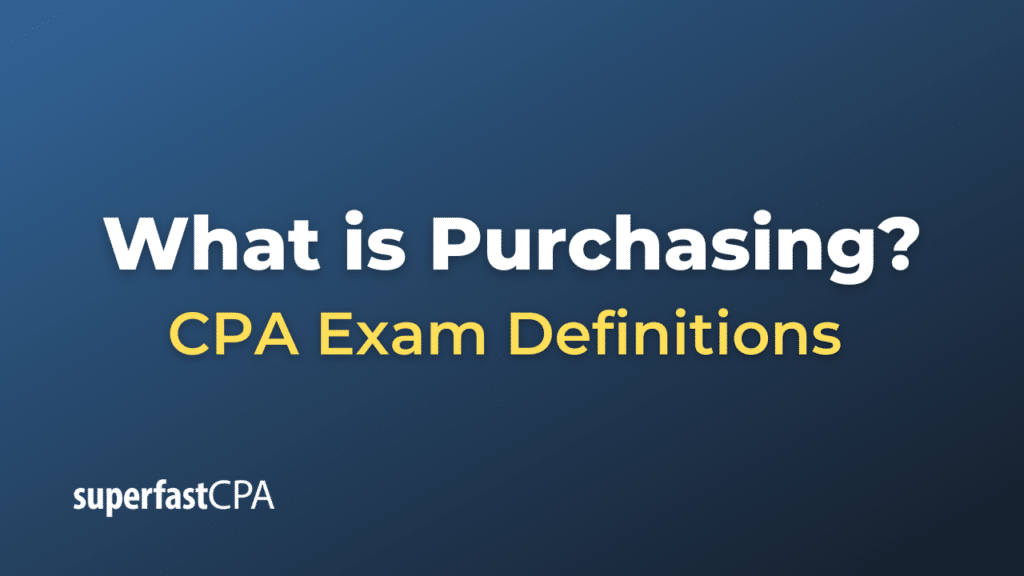Purchasing
Purchasing, in the context of a business or organization, refers to the process of acquiring goods or services needed for the operation of the business. It involves everything from identifying the need for a specific good or service, selecting suppliers, negotiating price and terms, and ensuring the delivery of goods or completion of services.
Purchasing is a key function in supply chain management and plays a crucial role in controlling the cost and quality of products or services. Efficient purchasing processes can contribute to a company’s profitability by ensuring the timely availability of goods or services at the best possible price.
The steps in a typical purchasing process might include:
- Identifying Needs: The first step in the purchasing process is determining what goods or services are needed. This could be based on a production schedule, customer orders, inventory levels, or other factors.
- Supplier Selection : Once the needs are identified, the next step is to find suppliers who can provide the required goods or services. This might involve research, getting quotes, and evaluating potential suppliers based on factors such as price, quality, reliability, and service.
- Price Negotiation and Contract Agreement: After a supplier is selected, the price and terms are negotiated and a purchase contract is created. This contract specifies the details of the purchase, including the price, delivery schedule, and terms of payment.
- Delivery and Receipt of Goods or Services : The supplier delivers the goods or completes the services as specified in the contract. The company checks the goods or services to make sure they meet the agreed-upon specifications and requirements.
- Payment: After the goods or services have been received and checked, the company pays the supplier according to the terms of the contract.
- Evaluation: After the purchase process is complete, the company may evaluate the supplier’s performance and the effectiveness of the purchasing process. This can provide valuable information for future purchasing decisions.
Purchasing can involve a variety of goods and services, from raw materials and machinery for manufacturing companies, to office supplies and consulting services for service-based businesses. The size and complexity of the purchasing function can vary greatly depending on the size and nature of the business.
Example of Purchasing
Let’s consider a simplified example of a purchasing process for a fictional furniture manufacturing company, “Comfort Creations”.
- Identifying Needs: Comfort Creations determines it needs 500 cubic feet of oak wood for the upcoming month’s production schedule to manufacture their best-selling oak dining tables.
- Supplier Selection: The purchasing department researches various suppliers who can provide oak wood and requests quotes. They evaluate potential suppliers based on price, quality of the wood, reliability, and delivery times.
- Price Negotiation and Contract Agreement : After comparing the quotes, the purchasing department chooses “Reliable Timbers” as their supplier. They negotiate a price of $2000 for 500 cubic feet of oak wood. Both parties agree on the price and delivery to be completed within two weeks.
- Delivery and Receipt of Goods: Reliable Timbers delivers the oak wood within the agreed-upon timeframe. The purchasing department checks the delivered wood to ensure it matches the quality specified in the contract.
- Payment: Once the quality of the wood is confirmed, Comfort Creations processes the payment of $2000 to Reliable Timbers, as per the terms agreed upon in the contract.
- Evaluation: After the process is completed, the purchasing department reviews the effectiveness of the process. They note that Reliable Timbers was able to deliver on time and provided high-quality oak wood. They decide to consider Reliable Timbers for future purchases as well.
This process helps Comfort Creations to ensure they have the necessary materials needed for their manufacturing while maintaining cost-effectiveness and efficiency. In a real-world scenario, the process can be far more complex with numerous other factors to be considered.













